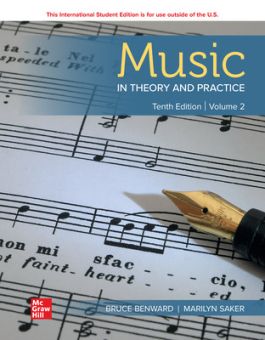ISE Music in Theory and Practice Volume 2
10th Edition
1260571033
·
9781260571035
© 2021 | Published: January 29, 2020
This best-selling text gives music majors and minors a solid foundation in the theory of music. It strengthens their musical intuition, builds technical skills, and helps them gain interpretive insights. The goal of the text is to instruct readers on…
Read More
Receive via shipping:
- Colour, print bound version of the complete text
PrefacePart A: The Renaissance And Baroque Periods
Chp. 1: Late Renaissance PolyphonyChp. 2: Two-Voice Eighteenth Century CounterpointChp. 3: The FuguePart B: Chromatic Harmony
Chp. 4: Borrowed ChordsChp. 5: Neapolitan 6th ChordsChp. 6: Augmented 6th ChordsPart C: The Classical Period (1750-1825
Chp. 7: Variation TechniqueChp. 8: Sonata FormChp. 9: Rondo FormsPart D: Extended And Chromatic HarmonyChp. 10: 9th,11th, and 13th ChordsChp. 11: Altered DominantsChp. 12: Chromatic MediantsPart E: The Nineteenth And Twentieth CenturiesChp. 13: The Romantic Period (1825-1900)Chp. 14: The Post-Romantic StyleChp. 15: Impressionism and Related StylesChp. 16: The Early Twentieth CenturyChp. 17: Pitch-Class Set TheoryChp. 18: Twelve-Tone TechniquePostlude: Music Since 1945AppendixesGlossaryCreditsIndex
Chp. 2: Two-Voice Eighteenth Century CounterpointChp. 3: The FuguePart B: Chromatic Harmony
Chp. 4: Borrowed ChordsChp. 5: Neapolitan 6th ChordsChp. 6: Augmented 6th ChordsPart C: The Classical Period (1750-1825
Chp. 7: Variation TechniqueChp. 8: Sonata FormChp. 9: Rondo FormsPart D: Extended And Chromatic HarmonyChp. 10: 9th,11th, and 13th ChordsChp. 11: Altered DominantsChp. 12: Chromatic MediantsPart E: The Nineteenth And Twentieth CenturiesChp. 13: The Romantic Period (1825-1900)Chp. 14: The Post-Romantic StyleChp. 15: Impressionism and Related StylesChp. 16: The Early Twentieth CenturyChp. 17: Pitch-Class Set TheoryChp. 18: Twelve-Tone TechniquePostlude: Music Since 1945AppendixesGlossaryCreditsIndex
Part B: Chromatic Harmony
Chp. 4: Borrowed ChordsChp. 5: Neapolitan 6th ChordsChp. 6: Augmented 6th ChordsPart C: The Classical Period (1750-1825
Chp. 7: Variation TechniqueChp. 8: Sonata FormChp. 9: Rondo FormsPart D: Extended And Chromatic HarmonyChp. 10: 9th,11th, and 13th ChordsChp. 11: Altered DominantsChp. 12: Chromatic MediantsPart E: The Nineteenth And Twentieth CenturiesChp. 13: The Romantic Period (1825-1900)Chp. 14: The Post-Romantic StyleChp. 15: Impressionism and Related StylesChp. 16: The Early Twentieth CenturyChp. 17: Pitch-Class Set TheoryChp. 18: Twelve-Tone TechniquePostlude: Music Since 1945AppendixesGlossaryCreditsIndex
Chp. 6: Augmented 6th ChordsPart C: The Classical Period (1750-1825
Chp. 7: Variation TechniqueChp. 8: Sonata FormChp. 9: Rondo FormsPart D: Extended And Chromatic HarmonyChp. 10: 9th,11th, and 13th ChordsChp. 11: Altered DominantsChp. 12: Chromatic MediantsPart E: The Nineteenth And Twentieth CenturiesChp. 13: The Romantic Period (1825-1900)Chp. 14: The Post-Romantic StyleChp. 15: Impressionism and Related StylesChp. 16: The Early Twentieth CenturyChp. 17: Pitch-Class Set TheoryChp. 18: Twelve-Tone TechniquePostlude: Music Since 1945AppendixesGlossaryCreditsIndex
Chp. 8: Sonata FormChp. 9: Rondo FormsPart D: Extended And Chromatic HarmonyChp. 10: 9th,11th, and 13th ChordsChp. 11: Altered DominantsChp. 12: Chromatic MediantsPart E: The Nineteenth And Twentieth CenturiesChp. 13: The Romantic Period (1825-1900)Chp. 14: The Post-Romantic StyleChp. 15: Impressionism and Related StylesChp. 16: The Early Twentieth CenturyChp. 17: Pitch-Class Set TheoryChp. 18: Twelve-Tone TechniquePostlude: Music Since 1945AppendixesGlossaryCreditsIndex
Part D: Extended And Chromatic HarmonyChp. 10: 9th,11th, and 13th ChordsChp. 11: Altered DominantsChp. 12: Chromatic MediantsPart E: The Nineteenth And Twentieth CenturiesChp. 13: The Romantic Period (1825-1900)Chp. 14: The Post-Romantic StyleChp. 15: Impressionism and Related StylesChp. 16: The Early Twentieth CenturyChp. 17: Pitch-Class Set TheoryChp. 18: Twelve-Tone TechniquePostlude: Music Since 1945AppendixesGlossaryCreditsIndex
Chp. 11: Altered DominantsChp. 12: Chromatic MediantsPart E: The Nineteenth And Twentieth CenturiesChp. 13: The Romantic Period (1825-1900)Chp. 14: The Post-Romantic StyleChp. 15: Impressionism and Related StylesChp. 16: The Early Twentieth CenturyChp. 17: Pitch-Class Set TheoryChp. 18: Twelve-Tone TechniquePostlude: Music Since 1945AppendixesGlossaryCreditsIndex
Part E: The Nineteenth And Twentieth CenturiesChp. 13: The Romantic Period (1825-1900)Chp. 14: The Post-Romantic StyleChp. 15: Impressionism and Related StylesChp. 16: The Early Twentieth CenturyChp. 17: Pitch-Class Set TheoryChp. 18: Twelve-Tone TechniquePostlude: Music Since 1945AppendixesGlossaryCreditsIndex
Chp. 14: The Post-Romantic StyleChp. 15: Impressionism and Related StylesChp. 16: The Early Twentieth CenturyChp. 17: Pitch-Class Set TheoryChp. 18: Twelve-Tone TechniquePostlude: Music Since 1945AppendixesGlossaryCreditsIndex
Chp. 16: The Early Twentieth CenturyChp. 17: Pitch-Class Set TheoryChp. 18: Twelve-Tone TechniquePostlude: Music Since 1945AppendixesGlossaryCreditsIndex
Chp. 18: Twelve-Tone TechniquePostlude: Music Since 1945AppendixesGlossaryCreditsIndex
AppendixesGlossaryCreditsIndex
CreditsIndex
This best-selling text gives music majors and minors a solid foundation in the theory of music. It strengthens their musical intuition, builds technical skills, and helps them gain interpretive insights. The goal of the text is to instruct readers on the practical application of knowledge. The analytical techniques presented are carefully designed to be clear, uncomplicated, and readily applicable to any repertoire.
The two-volume format ensures exhaustive coverage and maximum support for students and faculty alike. Volume I serves as a general introduction to music theory while volume II offers a survey of the theoretical underpinnings of musical styles and forms from Gregorian Chant through the present day. The supplemental instructor's materials provide clear-cut solutions to assignment materials. Music in Theory and Practice is a well-rounded textbook that integrates the various components of musical structure and makes them accessible to students at the undergraduate level.
The two-volume format ensures exhaustive coverage and maximum support for students and faculty alike. Volume I serves as a general introduction to music theory while volume II offers a survey of the theoretical underpinnings of musical styles and forms from Gregorian Chant through the present day. The supplemental instructor's materials provide clear-cut solutions to assignment materials. Music in Theory and Practice is a well-rounded textbook that integrates the various components of musical structure and makes them accessible to students at the undergraduate level.

